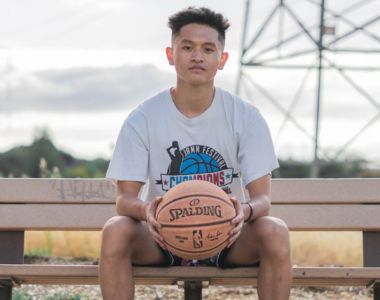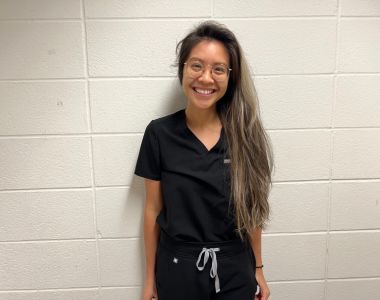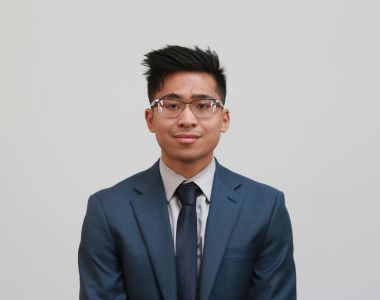From earning two degrees at Case Western Reserve and now working in the Department of Anatomy, to conducting research in the School of Medicine as an undergraduate student, to making strides on the varsity swim team while an integrated master’s business student, those of Filipino heritage are engaged with seemingly every facet of the university.
In recognition of Filipino American History Month, which takes place each year in October, The Daily is celebrating the accomplishments and experiences of three of those Filipino members of the CWRU community. Discover more about their experiences at Case Western Reserve—and learn how their heritage has impacted their lives.
Answers have been lightly edited for clarity and length.

Matthew Weng
Matthew Weng, a third-year systems biology major, was born and raised in Fremont, California, where there’s an active Filipino community. His mother, who is from the Philippines, and his father, who hails from Los Angeles with Taiwanese descent, both encouraged him to embrace his heritage.
For Weng, this month is an opportunity for those in his culture to celebrate their rich history, showcase traditions and embrace their heritage as he did growing up. Weng also believes Filipino American History Month serves as a medium for cultural exchange between individuals of diverse backgrounds.
“One thing people should take away from this month is the resiliency of our country,” Weng said. “The mid-20th century Philippines endured great struggles in war, natural disasters, and internal conflict—events from which much of my family emerged. Although we do not face some of these issues today, our resilient demeanor is conveyed through multiple avenues: sports, music, entrepreneurship, dance, faith and other outlets of expression.
“A misconception I have heard about Filipinos is that we tend to be nurses,” he added. “Although this stereotype is not in bad faith, perpetuating any stereotype positive or negative is harmful to any culture.”
Read on to learn more from Weng.
Q: What are some important aspects about your culture?
In my view, the most significant aspects of my culture are food, faith and family. I particularly cherish my mother’s sinigang, a dish that reminds me of her deep-rooted affection. Now that I am away from home, I have come to appreciate that it’s more than just a delicious meal; it embodies the essence of family, tradition, and the greater cultural identity of the Philippines.
Faith is equally important to my family. Beyond our weekly Sunday mass attendance, we actively engage with the Catholic community. My mother, for instance, sings in the choir and is president of The Filipino Community of St. Joseph where she organizes cultural events. Meanwhile, my father and I were basketball coaches for the Catholic Youth Organization where my little brother, Jon, plays. Connecting with my faith is a constant reminder to be grateful and allows my family and me to give back through community service.
Q: Why did you choose CWRU to study systems biology?
I learned about CWRU through my college counselor. I chose CWRU because it harbors a tight-knit student body and is supported by a distinguished biomedical community.
Systems biology utilizes math models to characterize, predict, and simulate a biological system. I chose to study this topic because it combines the disciplines of math and computer science to solve complex, multifactorial questions/issues in biology. Pertaining to my aspiring career as a biomedical researcher, systems biology provides a holistic understanding of a disease.
Q: Where experiences have you been involved with during your time at CWRU and what do you hope to do after you graduate?
I hope to get my PhD in biomedical science after graduation. From there, I hope to get into the biopharmaceutical industry where I can help others affected by disease.
Last summer, I interned at Boehringer Ingelheim, a pharmaceutical company. I was a quality control intern for their largest manufacturing site where I ensured the safety of our therapeutics and contributed to the commercial release of Cyltezo, a treatment for numerous inflammatory diseases such as Crohn’s disease and rheumatoid arthritis.I have also been conducting research as an undergraduate in Professor Carlos Subauste’s Lab at the School of Medicine since January 2022. I am deeply involved in studying the pathogenesis of diabetic retinopathy where I get to work with diabetic mouse models and run assays that assess retina tissue in humans.

Leina Lunasco
Leina Lunasco earned both her bachelor’s degree in medical anthropology and her master’s in applied anatomy from Case Western Reserve, but her connection to the university doesn’t stop there. She’s now a research associate in the Department of Anatomy under Andrew Crofton, where she’s working to dissect the vagus nerve and its branches from the medulla to its distal targets in the thorax and the abdomen in human cadavers.
“After being at CWRU for so long, this is undoubtedly the most exciting time in my career because of how interdisciplinary my work is,” Lunasco explained. “As anatomists, we collaborate with engineers, physicians, and histologists. The project involves using different imaging modalities such as MRI, microCT, and histology, to map out all of the branches and its different fiber types.”
Lunasco, whose family is from Dagupan City in the Philippines, grew up on the west coast of O’ahu, never more than 10 minutes from any beach. During her childhood, all members of her extended family were always, at most, 15 minutes away.
This month, Lunasco is reflecting on all the Filipino people in America have accomplished, making great strides in immigrant labor rights—and making up a big portion of the healthcare field.
“This month also allows me to reflect on how far my family has come,” Lunasco added. “For each generation of my lineage, education has furthered: my grandma had up to a 10th grade education, my mom graduated from a cosmetology trade school, and I now have a Master of Science degree and hopefully a Doctor of Medicine degree someday.”
Read on to learn more from Lunasco.
Q: Tell us about your role at CWRU—why are you passionate about it?
The main project that I am involved in is called Reconstructing Vagal Anatomy (REVA), which is led by Andrew Shoffstall from CWRU’s Department of Biomedical Engineering, and is a collaboration between CWRU and Duke University. I honestly feel like I learn something new each day with the amount of anatomical variation we see.
The overall goal of the project is to better understand how the vagus nerve, the key regulator of our body’s parasympathetic nervous system, is organized so we can leverage that information to design more effective neuromodulation devices and therapies for autonomic regulation. Vagus nerve stimulation (VNS) is an FDA approved therapy to treat epilepsy and treatment-resistant depression, with many ongoing trials investigating its efficacy in countless other chronic illnesses. Unfortunately, this therapy can have many off-target effects due to the nerve’s extensive and variable branching pattern and its proximity to other important nerves.
Q: What has your career path looked like so far?
In high school, I had my sights set for eventually going to medical school, so I made sure to attend a college that was surrounded by hospitals so I could shadow, volunteer, and possibly work there. I had not heard of CWRU prior to seeing it on the CommonApp and it was free to apply at the time, so I applied on a whim. As I looked more into the campus, I saw its proximity to all of the healthcare systems and got more excited after visiting the campus. What better place to move to than Cleveland, Ohio! My family was of course devastated that I moved to the other side of the country with such a big timezone difference.
I took an involuntary break during my undergraduate studies to address my mental health, and although I didn’t know it at the time, it definitely contributed to the person I am today. During that time, I worked as a waitress, nurse assistant, and researcher, with profound lessons learned with each position. Being away from school for a couple years, I started to doubt my academic abilities and debated with myself whether I was cut out for medical school. After graduating from undergrad, I enrolled in the master’s of anatomy program, which brought me to my current position as a research associate within the department. Pursuing the master’s program is easily the best academic decision I’ve made.
Q: Anything else you’d like to add?
Growing up, I’ve had many interactions with doctors via my older sister being born with a congenital heart defect and having to undergo several major surgeries throughout our childhood. I’d always tag along to doctor’s visits, but something that became more apparent to me as I got older was that very few of the physicians that I’ve interacted with were Filipino. Despite the fact that a considerable amount of Hawaii’s population have Filipino ancestry, I rarely encountered a Filipino doctor! My curiosity in medicine really bloomed in high school as I started to learn and understand the complexities of my sister’s condition. I was determined to become a Filipino physician, which was terrifying since no one in my family was in the medical field and I was a first generation college student.

Alexander Guerrero
Alexander Guerrero, an integrated studies student at Weatherhead School of Management, finished his bachelor’s degree in economics earlier this year and is pursuing his master’s in finance.
“I see economics as a way to understand how the world works qualitatively and finance as a way to see how the world works quantitatively,” Guerrero explained.
Though his family hails from the Philippines, specifically Quezon City, Guerrero was born in Chicago and raised in suburban Illinois. He sees this month as a time to represent Filipino culture to its fullest.
“To me, that means celebrating how Filipino culture has integrated into the United States,” he noted, “and how Filipino-American culture has adapted for immigrant families.”
Read on to learn more from Guerrero.
Q: What are some important aspects about your culture?
One important aspect about my culture is religion. The majority of The Philippines is Roman Catholic, so I grew up going to Catholic school. Catholicism plays an important role in my family’s culture as we celebrate many Catholic holidays as they would in the Philippines. Another important aspect is food. My mother is an amazing cook, and she makes a lot of Filipino food like Lumpia, Adobo and Lechon.
Q: Why did you choose CWRU to study economics and finance?
I chose to attend CWRU because I was a recruited swimmer. On my recruiting trip, I enjoyed the academic and athletic opportunities the school had and saw that the school culture could balance my pursuits in both fields.
Q: Where experiences have you been involved with during your time at CWRU and what do you hope to do after you graduate?
I have completed several internships. I interned at a startup company, and I have also interned at KeyBank twice. On campus during my undergraduate career, I was on the varsity swim team. The experience on the swim team was pivotal for me as it allowed me to learn about working through adversity as a team.
After graduation, I will be an analyst at KeyBank, where I have interned for the past two summers. I hope to continue learning about how the world works through the banking system.
